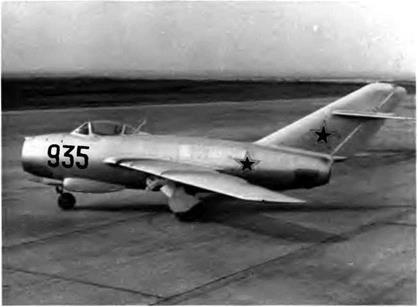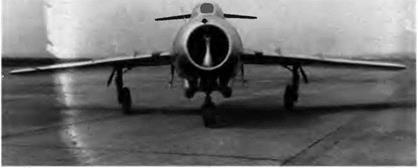MiG-15 / SU
From the inception of fighter aircraft in World War I, pilots aimed at objects in the air or on the ground by pointing the aircraft so that the target appeared in the gunsight’s cross hairs. The fighter’s armament
|
The MiG-15 no. 935 was modified to be equipped with an experimental weapons system having a limited slew angle |
was fixed, making it difficult to direct (especially at high speed). Pilots had little time to aim and fire at their targets.
This is why aircraft manufacturers and armament specialists joined forces to develop rotating gun systems to simplify aiming and firing sequences for the fighter pilot and thereby to guarantee a decisive tactical advantage in dogfights. In late 1949 OKB engineers and armament experts decided to design an experimental weapon system with a limited slew angle and to test it on a MiG-15. It was one of the very first installations of the kind in the USSR.
First, cannons of a new type —23-mm Shpitalniy Sh-3s—were installed in a MiG-15 bis (ISh). They had standard mountings and passed their firing tests. On 14 September 1950 the council of ministers ordered MiG-15 no. 109035, built in factory no. 1 at Kuybyshev, to be sent to the OKB’s experimental workshop and equipped with the limited slew angle V-l-25-Sh-3 weapon system, which consisted of two experimental 23-mm Sh-3 short-tube cannons with 115 rpg. The specification called for the weapons to rotate in the vertical plane (11 degrees upward, 7 degrees downward) concurrently with a synchronous displacement of the gunsight in the cockpit. The aim of the cannons was remotely controlled by two switch knobs—one on the throttle (RUD) and one on the stick (RUS) Either knob could be used.
|
A front view of the V-l-25-Sh-3 weapons system with its two 23-mm Sh-3 cannons. |
The specifications and performance of the SU were virtually identical to those of the MiG-15 with the RD-45F engine. The MiG-15 (SU) no. 109035 was tested by Yu A. Antipov and sent to the Nil WS on 20 June 1951 for state trials, which took place from 30 June to 10 August. The aircraft was put through its paces by military test pilots such as Trofimov, Makhalin, Dzyuba, Lukin, Kotlov, Tupitsin, and Filippov. They made sixty-three flights with a total of forty-two hours and forty – six minutes of flying time. The rotating elements of the new weapon system functioned for fifty-two hours, with the cannon pivoting for six and one-half hours
Firing tests in flight gave prominence to the tactical advantages of the SU over the production MiG-15, but these advantages were tempered by the relatively small angular movement of the cannons and by the limited possibilities of the ASP-3N production gunsight. Combat simulations were staged against an 11-28 and a MiG-15 bis. These proved that the V-l-25-Sh-3 could widen the possibilities of head-on attacks without a risk of collision. At a distance of 800 m (2,600 feet) and identical load factor for both the target and the attacker, the SU could fire at a heading angle 7 to 13 degrees wider than that of a conventionally armed Fighter. The pivoting Sh-3 also made possible a much longer burst. The trial attacks on the 11-28 were launched from the rear from quadrants two and three, while the combat with the MiG – 15 bis took place at 15,000 m (49,200 feet).
Tests showed that fifteen to twenty flights were sufficient to train pilots to operate the new system; compared to the three-cannon standard armament, the new layout was more straightforward. In-flight exercises also demonstrated that firing at extreme slew angles did not affect the aircraft’s speed and trim at 5,000 m (16,400 feet) but did
|
Close up of one of the two Sh-3 cannons, which rotated only in the vertical plane between +11 and -7 degrees |
detract from the lateral stability somewhat Moreover, because of a minor buffeting produced by rudder deflection, undamped oscillations were generated at Mach 0.845 on the longitudinal and vertical axes. The aircraft’s ground handling deteriorated because of the much larger turning radius entailed by the V-l-25-Sh-3 installation. Its ranging display system also proved to be too slow.
These first tests with limited slew angle cannons proved that it was essential to widen the angles—to 25-30 degrees upward and 10-15 degrees downward—and to use an automatic gunsight. A mobile gun – sight was tested on the experimental MiG-15 to assess its simplicity of operation. Another attempt of this kind was made in 1953-54 with the SN, an experimental member of the MiG-17 family.
|
The two drop tanks of the MiG-15 bis—capacity 250 1 (66 US gallons)—were braced. |














